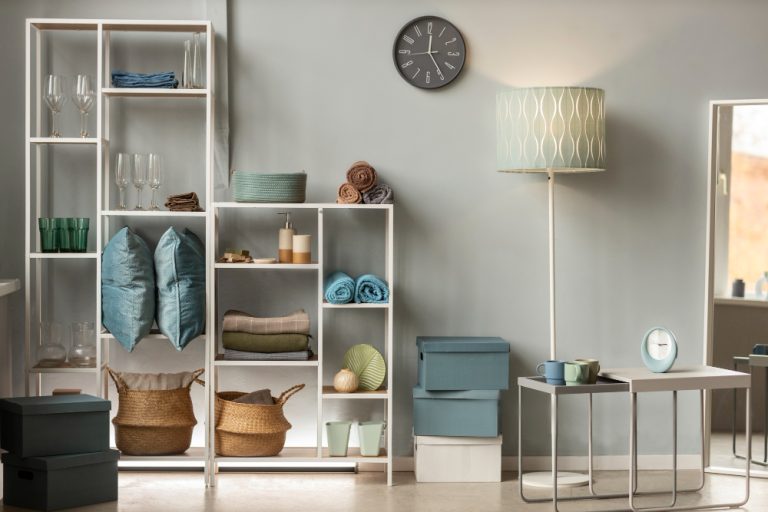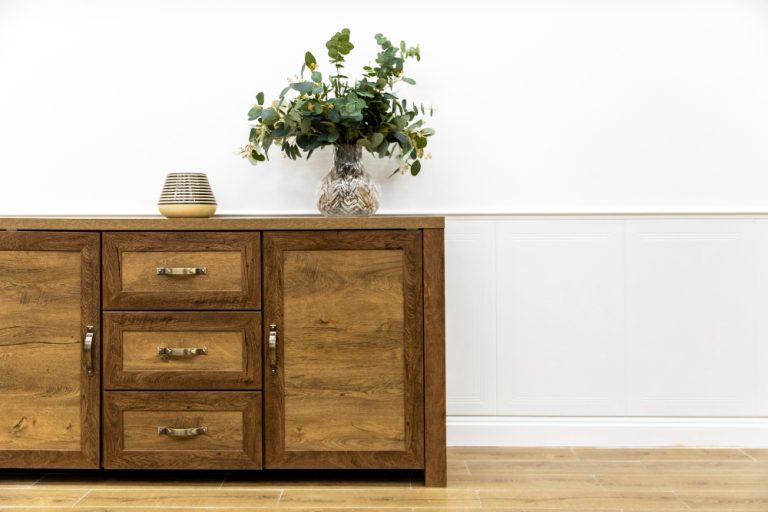Looking for DIY ceiling ideas? Try easy upgrades like breadboard, painted tiles, faux beams, or peel-and-stick panels. They’re budget-friendly, renter-safe, and perfect for refreshing any room—no pro needed.
Tired of staring at a plain or outdated ceiling? You’re not alone. Many people overlook the ceiling when decorating, even though it makes a big difference in a room’s style. The good news? You don’t need to hire a contractor or spend a fortune to give it a fresh new look.
In this guide, you’ll discover simple DIY ceiling ideas that are easy to follow, low-cost, and big on impact. Whether you rent or own your home, there’s something here for every space and skill level. Let’s walk through each option with real examples, clear steps, and smart tips.

Popular DIY Ceiling Ideas for Every Room
Shiplap and Wood Planks

Shiplap is a favorite for adding charm and texture to a ceiling. It works well in living rooms, bedrooms, and even kitchens. You can buy ready-made planks from most hardware stores. Some are even peel-and-stick for easier installs.
Wood planks give a warm, rustic look. Choose between pine, cedar, or reclaimed wood. Nail or glue them to ceiling joists for a lasting upgrade. If you’re renting, use removable panels or try faux wood tiles. This style pairs well with farmhouse, coastal, and cottage themes. You’ll find plenty of inspiration and tips on sites like HGTV.
Beadboard Panels

Beadboard is easy to work with and looks great in small spaces like bathrooms or hallways. It’s usually white but can be painted any color. For a DIY job, you can use full sheets or narrow strips.
Attach beadboard with adhesive and finishing nails. Cover seams with trim for a clean look. It’s lightweight and affordable, which makes it perfect for quick upgrades.
You’ll get the best result by priming and painting before installation. Moisture-resistant types are ideal for bathrooms. Check out This Old House for a step-by-step guide.
Faux Beams and Coffered Ceilings

Faux wood beams create the look of heavy timber without the weight or cost. These beams are made of lightweight polyurethane. You can install them with screws or construction adhesive. No ceiling support needed.
Coffered ceilings use a grid of beams to make square or rectangular sections. It’s a bold style often seen in dining rooms or entryways. Though more complex, kits and detailed guides help make the process simple. These ideas add a high-end look for less. Learn more about styles and materials at Architectural Digest.
Painted Ceilings

Paint is one of the easiest DIY upgrades. A bold color like navy, black, or blush pink makes a ceiling pop. Soft colors like sky blue or cream create a light, airy feel.
Use flat or matte paint to reduce glare. Clean the surface first, and use a roller with an extension pole. If you want texture, try sponge or stencil techniques.
For a dramatic touch, match the ceiling color to the walls. For contrast, choose a shade lighter or darker than the wall. Browse Sherwin-Williams for color inspiration.
Materials and Tools You’ll Need
Common Tools for DIY Ceiling Projects
Most ceiling updates need only basic tools. Here’s a list of what you may use:
| Tool | Use |
|---|---|
| Measuring tape | To mark and cut boards or tiles |
| Level | To keep lines straight |
| Ladder or scaffold | For safe access to high spots |
| Stud finder | To locate ceiling joists |
| Drill and screws | For beams, wood planks, or tiles |
| Adhesive and caulk | For beadboard or peel-and-stick panels |
| Utility knife | For trimming lightweight materials |
| Paint supplies | For any painting or touch-up work |
These are easy to find at local stores or online. Rent larger tools if you don’t have them.
Materials Based on Project Type
Different ceiling ideas need different supplies. Use the table below to match materials to your project:
| Project Type | Materials Needed |
|---|---|
| Shiplap/Wood Planks | Wood boards, nails or screws, adhesive |
| Beadboard Panels | Beadboard sheets, trim, paint, adhesive |
| Faux Beams | Polyurethane beams, screws, adhesive |
| Painted Ceilings | Primer, ceiling paint, brushes, rollers |
| Peel-and-Stick Tiles | Lightweight tiles, adhesive, level |
| Coffered Ceilings | MDF or wood trim, base paint, saw, fasteners |
Use moisture-resistant materials in bathrooms and kitchens. Always check for ceiling damage or mold before starting.
Budget-Friendly Options That Still Look Great
Peel-and-Stick Ceiling Tiles

Peel-and-stick tiles are a smart pick if you’re on a tight budget. They come in many colors and patterns, and they’re super easy to apply. You don’t need special tools—just a clean, flat surface.
Many tiles mimic wood, metal, or tin. These tiles work well in apartments because they’re easy to remove. You can find affordable options at Wayfair and Amazon.
Painting for Instant Impact
Paint is low-cost and goes a long way. Even one gallon can refresh a ceiling in a living room or bedroom. Use leftover wall paint for extra savings.
Add stripes, borders, or geometric patterns for more style. Use painter’s tape to keep lines sharp. Visit Benjamin Moore for tips on ceiling paint.
Repurpose What You Have
You can reuse old wood, trim, or tiles. Salvage yards or thrift stores often carry building supplies at a discount. Try Facebook Marketplace or Craigslist for local finds.
Even cardboard or foam panels can become beautiful ceiling decor with the right paint or covering. Just make sure it’s safe and lightweight.
These tips help keep costs low while still making your ceiling look amazing. You’ll get a fresh, stylish room without breaking the bank.
Step-by-Step Guide to Installing Your DIY Ceiling Upgrade
Step 1: Measure Your Ceiling
Start by measuring the full width and length of the ceiling. This helps you plan how much material you’ll need. Always double-check your numbers to avoid waste or shortages.
Sketch a basic layout. This helps with tile placement or plank direction. Use a tape measure and a level to keep your lines straight and even.
Step 2: Choose and Prep Your Materials
Pick materials that suit your room and budget. For example, use beadboard or peel-and-stick tiles for small rooms, and wood planks or beams for larger spaces.
Let wood and similar products acclimate indoors for 24–48 hours before installation. This prevents warping or cracking. Clean the ceiling surface so paint or adhesive will stick better.
You can find detailed prep tips on trusted home project sites like Family Handyman.
Step 3: Mark and Plan the Layout
Mark the center of the ceiling and plan from there. This keeps the design balanced. Use chalk lines to help align planks or panels.
If you’re doing a pattern, test it on the floor first. It’s easier to fix layout issues before gluing anything in place.
For grid-style ceilings, such as coffered or beam layouts, mark your grid lines ahead of time. A laser level can be very helpful.
Step 4: Install Your Chosen Ceiling
Follow product instructions carefully. For peel-and-stick, remove the backing and press firmly into place. Use a roller to apply pressure.
For wood planks, nail or glue each board to the ceiling joists. Stagger the boards like flooring for a more natural look.
Faux beams usually need just a few screws and construction adhesive. Pre-drill holes to avoid cracking.
If painting, do two coats for better coverage. Use painter’s tape to keep edges neat. Find ceiling painting advice at Behr.
Step 5: Add Trim and Finishing Touches
Use trim or molding to cover seams, edges, or gaps. This gives the ceiling a polished, finished look.
Fill nail holes and touch up with paint or caulk. Clean the area and put your tools away. Now your ceiling is done!
Room-by-Room Ideas and Inspiration
Living Room

The living room is where guests spend the most time, so this is a great place to make a statement. Try faux wood beams or a coffered ceiling for a classic feel. If you like a clean look, go with white shiplap or soft-colored paint.
To add warmth, mix ceiling updates with new lighting. A central chandelier or recessed lights go great with beams or planks. Check out ideas on Better Homes & Gardens.
Kitchen

Ceilings in kitchens get steamy and messy. Use moisture-resistant materials like vinyl beadboard or tin-look tiles. These are easy to wipe clean and resist damage.
A painted ceiling also works well here. Try soft gray or cream to match cabinets. Add under-cabinet lighting to tie the room together.
Bedroom

Bedrooms are perfect for cozy or elegant ceiling styles. Use painted planks or beadboard in calming colors like pale blue or lavender. These tones help you relax.
For a luxe feel, try a simple coffered ceiling or a bold color. Add soft lighting like pendant lamps or flush-mount fixtures. You can find design inspiration on Houzz.
Bathroom

Bathrooms need materials that handle humidity. Vinyl panels, paint, or lightweight ceiling tiles work well. Avoid wood unless it’s sealed and protected. Try white or light blue to make the room feel bigger. Add LED lights or a moisture-safe fan for function and comfort.
Small Spaces
In hallways or laundry rooms, go bold with color or patterns. Try stick-on tiles with texture or a two-tone painted ceiling. These spots are perfect for testing ideas before using them in big rooms.
FAQs About DIY Ceiling Projects
What is the easiest DIY ceiling idea?
Painted ceilings are the easiest and cheapest option. You only need paint, a roller, and a ladder. Peel-and-stick tiles are also beginner-friendly and need few tools.
How much does it cost to upgrade a ceiling yourself?
Costs range from $1 to $5 per square foot, depending on materials. Paint is cheapest. Faux beams or real wood can cost more. You can keep costs low by using leftovers or repurposed items.
Can I install ceiling upgrades if I rent?
Yes, use removable options like peel-and-stick tiles or ceiling decals. Avoid nails or permanent glue. Always check your lease or ask your landlord first.
Do I need to find ceiling joists?
Yes, for heavy items like wood planks or beams, you should screw into joists. For light items like tiles or beadboard, strong adhesive is enough. Use a stud finder to locate joists.
What type of ceiling works best in bathrooms?
Use moisture-resistant materials like vinyl panels or paint. Avoid real wood unless it’s sealed. Stick-on tiles made for wet areas are also a good choice.
Is it okay to use leftover materials from other projects?
Yes! Reusing wood, trim, or tiles helps you save money and reduce waste. Just make sure they’re clean and safe for ceiling use.
Final Thoughts
Upgrading your ceiling doesn’t have to be hard or expensive. With just a few tools and smart materials, you can turn a plain ceiling into a stylish feature. Whether you go bold with beams or subtle with paint, each idea brings life to your room.
Try one idea at a time and build confidence. Most projects can be done in a weekend. If you plan carefully and follow simple steps, the result will be clean, safe, and beautiful. Start small if you’re unsure, and enjoy the process. Your ceiling might just become your favorite part of the room.
Read More:







